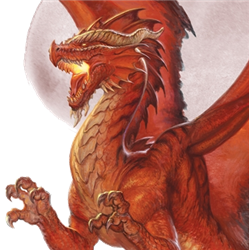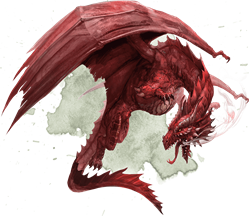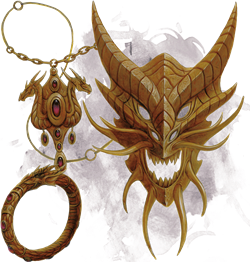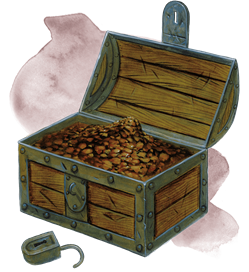How to Play a Red Dragon like an Evil Genius
The red dragon swooped down from the ash-choked sky, smoke bellowing from its nostrils, and landed in the middle of a group of adventurers as they approached its lair. It reared back its head and spewed forth a cone of roaring flames, engulfing one of the warriors. But a perplexed expression crossed its arrogant jaw when the smoke cleared to reveal that its target was barely even singed.
Fortunately for the adventurer, the ring of fire resistance she picked up in the last town cut the damage in half. She also happened to be a rogue, and even though she failed her saving throw against the fire breath, her Evasion feature cut the damage in half again.
Then the dragon’s turn ended, and it found itself outnumbered, without allies, outside its lair, without its breath weapon, and surrounded on solid ground. Even with its impressive AC and hit points, the characters slaughtered it in one round.
If this experience sounds familiar, you’re not alone. Red dragons are among fantasy’s most iconic villains because of their incredible physical strength, genius-level intelligence, shrewd guile, and dark charisma. And, of course, because they can fly with the agility of a fighter jet. All of the qualities that make a red dragon terrifying to players are, ironically, also what make them so hard to play as a Dungeon Master. Playing a red dragon demands genius-level forethought and perfect combat tactics, so it’s hard as hell to play one in a way that satisfies both you and your players.
But not impossible. Playing a red dragon like the evil genius it is requires getting into its head and thinking like it would think. It's a common misconception that roleplaying and tactical combat are two separate states of gaming, but they are inexorably linked. Roleplaying is more than just talking in character, it's making choices based on how your character, in this case a red dragon, would act. Playing an ogre in this way is easy, just hit whatever's in front of you. Playing a red dragon with an Intelligence score of 18 is a bit trickier. A dragon is only as smart as the Dungeon Master playing it, but even smart DMs have off-days. The challenge ultimately comes from mastering the red dragon's suite of abilities while doing the ten billion other things a DM has to do, like controlling the dragon’s minions, adjudicating its lair actions, and managing your players, to name a few. This article will help you play a beastly red dragon, leaving you some spare brainpower free to handle the little things.
Planning like a Dragon
 As a red dragon, you are not a common brute; you are a mastermind with an intellect as sharp as your talons. Even freshly hatched red dragon wyrmlings are smarter than the average human being; compare a human commoner’s 10 INT to a red wyrmling’s 12 INT. You should never be caught off-guard by an adventuring party casually approaching your lair, and you should know exactly who has the dragon slayer longsword and who’s wearing the ring of fire resistance.
As a red dragon, you are not a common brute; you are a mastermind with an intellect as sharp as your talons. Even freshly hatched red dragon wyrmlings are smarter than the average human being; compare a human commoner’s 10 INT to a red wyrmling’s 12 INT. You should never be caught off-guard by an adventuring party casually approaching your lair, and you should know exactly who has the dragon slayer longsword and who’s wearing the ring of fire resistance.
The only reason a mastermind dragon should be caught off-guard by an adventuring party is if the characters invest heavily and cleverly in remaining unseen. This could involve hiring counter-spies to sow false rumors about their plans, or liberal use of spells like nondetection and pass without trace to conceal their movements. As a mastermind dragon, you should always prepare for the characters’ arrival at its lair. This includes the following:
Spy on the characters to learn about their gear and tactics. Put sticky notes on your DM screen reminding you of major hazards to avoid, such as dragon-slaying magic items, and of the party’s major weaknesses, such as a cleric with poor Dexterity. And if you know of a devastating strategy that the characters have devised to slaughter you, your hoard should include magic items that counteract the plan. A crystal ball is an excellent tool to explain how you knew every detail of their plans, and if the characters defeat you and find the item in your hoard, they’ll enjoy unraveling the mystery of how you prepared so well for their arrival.
Never confront the characters outside your lair. You are at your most powerful inside your lair. Lair actions give you a huge edge in combat, so you should never fight to the death outside of it. However, you should also…
Harass the characters before they reach your lair. If you know your enemies are coming to kill you, you must weaken them before they arrive on your doorstep. Force them to react to you flying far overhead while they struggle with rocky, mountainous terrain and your salamander minions. Then, even if you take a few hits, you can retreat to your lair and take a short rest before the characters arrive. You can even patrol the surrounding area to interrupt their short rests, forcing them to fight you at a disadvantage.
The ability to harass earthbound foes from the air is essential; don’t employ this tactic if the characters can easily ground you or pursue you in flight!
Fighting like a Dragon
 Dragons don’t fight fair. While you may possess incredible raw power, and might even have Legendary Resistances that can get you out of stupid situations, evil geniuses never get into stupid situations if they can help it. It’s tempting to just land in front of the characters and wail on them with your many devastating attacks, but all that does is leave you open to an even deadlier counterattack.
Dragons don’t fight fair. While you may possess incredible raw power, and might even have Legendary Resistances that can get you out of stupid situations, evil geniuses never get into stupid situations if they can help it. It’s tempting to just land in front of the characters and wail on them with your many devastating attacks, but all that does is leave you open to an even deadlier counterattack.
A Dragon’s Abilities
If you want to play a tactical mastermind, you need to know exactly what your options are on every turn. This will help you make purposeful choices rather than guessing at what choice is best in the heat of the moment. These options are:
Move. Your movement options are some of your strongest defensive tools, if used properly. You have a walking, climbing, and flying speed, but your flight is easily the most useful of the three. With a flying speed of 80 feet (60 as a wyrmling), you can outpace any would-be dragonslayer using the fly spell, a broom of flying, and most carpets of flying, as well as aarakocra, Draconic Bloodline sorcerers, Divine Soul sorcerers, and Storm sorcerers. This lets you reposition yourself in three dimensions within combat and even flee losing battles.
Aarakocra monks and monks that can gain a flying speed equal to their walking speed, such as with winged boots, still pose a problem, but are fairly rare.
Fire Breath. Your breath weapon is your most dangerous tool, and when used properly can throw an entire party of adventurers into chaos on the first turn of combat. Use this ability as soon as possible, since the adventurers will likely still be clustered on the first turn of combat, and use your lair actions to keep them from splitting up to avoid further breath weapon attacks. Even if they aren’t clumped up, your ability to fly should allow you to position yourself well enough to catch at least half of them at any time.
Frightful Presence. Frightening your enemies is a powerful effect, but most adventurers have easy ways to counteract it, such as the heroism spell at low levels and heroes’ feast at higher levels. If you have learned that your party has few ways to counteract being frightened, you should use this action early in combat to make it hard for the party to attack you, allowing you to pick off soft targets like back-line spellcasters.
Attack. Your suite of melee attacks are impressive, but they aren’t your main weapon. They do decent damage, but lack “rider effects” like automatic grapples and incapacitating poison that make other monsters deadly melee combatants. Your melee attacks stand out because of their exceptional reach (especially as an ancient dragon), allowing you to make hit-and-run strikes without provoking opportunity attacks.
Blindsight. Don’t forget about blindsight! It allows you to see nearby invisible creatures, preventing them from hiding from you without cover, and negating the combat advantages of invisibility.
Legendary Resistance. This is your most powerful defensive option (as an adult or ancient dragon only), but don’t waste it. Use your three precious uses of Legendary Resistance to avoid crippling save-or-suck effects like confusion, but don’t use it to avoid damage unless the damage would kill you otherwise.
Legendary Actions. It’s easy to forget about these actions which you can use at the end of any other creature’s turn (as an adult or ancient dragon only). The Detect action can help you observe hidden characters, but is generally one of the weaker choices. The Tail Attack action lets you increase your damage output if you have nothing else to do with your legendary actions. Most importantly, your Wing Attack action lets you escape from lockdown situations by possibly knocking nearby enemies prone (imposing disadvantage on their opportunity attacks), and then letting you move up to 40 feet.
A Dragon’s Tactics
Even though you have a litany of powerful combat options, you need to use them tactically in order to defeat clever or well-equipped adventurers.
Your tactics will vary based on its foes’ party composition and the personality of the dragon you’re playing, but a good tactical loop for a dragon is:
- Hide until the characters are within 80 feet. Once you’ve engaged, stay airborne as much as possible to avoid melee attacks.
- Fly to 40 feet out and use Fire Breath to catch as many characters as possible, and never end your turn within 30 feet of the characters. Use Fire Breath whenever it recharges, and retreat to cover while it is recharging if attacking in melee is too dangerous.
- Fly in and use Frightful Presence, then on subsequent turns attack creatures that weren’t frightened. The frightened characters have disadvantage on attacks against you, and are less threatening.
- Use lair actions to force the characters to clump together, allowing you to devastate them with your Fire Breath when it recharges.
A Dragon’s Innate Magic
 In earlier editions of D&D, most dragons were also spellcasters. A variant rule in the Monster Manual lets a dragon know a number of spells equal to its Charisma modifier, expanding your tactical arsenal without causing a severe increase in power level (or challenge rating). You can give dragons spells from any class’s spell list, allowing you to create some interesting flavor for each dragon; a red dragon with druid or paladin spells tells a very different story than one with sorcerer spells! Here are a few sample spell lists using sorcerer spells to give you options for a simple spellcasting dragon, but you should customize your spells to suit your villain’s character.
In earlier editions of D&D, most dragons were also spellcasters. A variant rule in the Monster Manual lets a dragon know a number of spells equal to its Charisma modifier, expanding your tactical arsenal without causing a severe increase in power level (or challenge rating). You can give dragons spells from any class’s spell list, allowing you to create some interesting flavor for each dragon; a red dragon with druid or paladin spells tells a very different story than one with sorcerer spells! Here are a few sample spell lists using sorcerer spells to give you options for a simple spellcasting dragon, but you should customize your spells to suit your villain’s character.
An ancient red dragon knows 6 spells of up to 8th level, and can cast each once per day. A sample spell list is crown of stars, elemental bane, etherealness, finger of death, power word pain, and whirlwind, giving the dragon a way to prepare for battle, cluster its targets, and flee combat if needed. Elemental bane is a sneaky way to overcome the party's now-pitifully common fire resistance.
An adult red dragon knows 5 spells of up to 5th level, and can cast each once per day. A sample spell list is control winds, elemental bane, far step, greater invisibility, and synaptic static, allowing the dragon tools to escape from lockdown situations, debuff its enemies, and make full use of its impressive suite of melee attacks.
A young red dragon knows 4 spells of up to 3rd level, and can cast each once per day. A sample spell list is erupting earth, fireball, haste, and stinking cloud, helping the dragon limit its enemies’ movement options and deal damage while its breath weapon is recharging.
A red dragon wyrmling knows two spells of 1st level and can cast them both once per day. A sample spell list is earth tremor and shield. These spells give it some defensive options, while preserving the feel of a baby dragon instinctively using its uncontrolled magic powers.
A Dragon’s Hubris
 Dragons may be intelligent creatures, but they are not without their fatal flaws. If you’re going to play intelligently and even metagame a bit, you should also give yourself weaknesses that smart players can exploit in a fun and dramatic way. Anyone who has read The Hobbit knows that the dragon Smaug is laid low in the end by his arrogance and his greed because Bilbo was able to flatter and fool the dragon into revealing a weakness that Bard the Bowman later exploited with a well-placed arrow.
Dragons may be intelligent creatures, but they are not without their fatal flaws. If you’re going to play intelligently and even metagame a bit, you should also give yourself weaknesses that smart players can exploit in a fun and dramatic way. Anyone who has read The Hobbit knows that the dragon Smaug is laid low in the end by his arrogance and his greed because Bilbo was able to flatter and fool the dragon into revealing a weakness that Bard the Bowman later exploited with a well-placed arrow.
The best part of any dragon fight is when the characters transform a dragon from a tactical super-genius into an arrogant fool or a rampaging beast. This can be true both for players and for Dungeon Masters; playing a dragon intelligently and tactically is hard work, and it can feel good to just wail on the players without all of the hiding and taunting. The only way you can make this transformation feel natural, however, is if it fits the characters’ actions, and you have to sell the transition through your roleplaying.
If the characters are seriously struggling to defeat the dragon at its tactical best, it is perfectly in character for a red dragon to swagger out of hiding and deliver a pompous monologue about how they are all doomed. This gives the characters a chance to heroically turn the tide of battle, or to run and fight another day. Both are excellent dramatic options, and can become gaming stories that are told for years to come.
The players, however, can use their own roleplaying skills to lure you into fighting foolishly. Look at the red dragon’s description in the Monster Manual to see a litany of personality traits… many of them massive character flaws. Red dragons are “arrogant tyrants” that “fly into destructive rages and act on impulse when angered.” If you play these traits as boldly as you play the dragon’s tactical intelligence, you give players that like story and character development more than combat a way to make the battle a little easier.
If you boast about the size of your treasure hoard, characters might decide to go searching through to steal baubles during combat. Those characters make Charisma checks opposed by your Wisdom (Insight) check as they root around, enraging and distracting you if they succeed on the check. There’s nothing a dragon hates more than a thief, and it will drop everything to retrieve its gold—as the Monster Manual says, red dragons “notice the absence of a single coin, igniting its rage as it tracks down and slays the thief without mercy.” A rampaging dragon is not a cunning mastermind, but a creature that will charge headlong into danger, trampling kobold minions as it goes, in order to protect its fragile ego.
Having Fun Playing a Dragon
Dragons, like any campaign-defining villain, deserve a dramatic fight. This drama can be attained through high narrative stakes or through great roleplaying, but it helps to support it with a tough-as-nails combat. The peak of D&D is when a challenging dungeon exploration culminates in a high-stakes combat that could just as easily end in a TPK as a victory.
Or it is for me, anyway. The simple fact is that you might like a simple slug-it-out fight, and your players would much rather enjoy easy combats against a foe that’s fun to taunt and banter than stress out about losing their characters. If your idea of an evil genius is more Dr. Evil than the Kingpin, these tactics can still work for you, just adjust the intensity down a little bit. As long as everyone’s having fun, you’re playing D&D right.
Now go toast some adventurers!
 James Haeck is the lead writer for D&D Beyond, the co-author of the Critical Role Tal'Dorei Campaign Setting, and writes as a freelancer for Wizards of the Coast, the D&D Adventurers League, and Kobold Press. He loves dragons more than life, enjoys roleplaying and tactical combat in equal measure, and lives in Seattle, Washington with his two wyrmlings, Mei and Marzipan. You can usually find him wasting time on Twitter at @jamesjhaeck.
James Haeck is the lead writer for D&D Beyond, the co-author of the Critical Role Tal'Dorei Campaign Setting, and writes as a freelancer for Wizards of the Coast, the D&D Adventurers League, and Kobold Press. He loves dragons more than life, enjoys roleplaying and tactical combat in equal measure, and lives in Seattle, Washington with his two wyrmlings, Mei and Marzipan. You can usually find him wasting time on Twitter at @jamesjhaeck.








-
View User Profile
-
Send Message
Posted Mar 8, 2018For a different take, grapple random party member (or toughest looking, if you prefer). Fly away with them, gain some serious altitude, drop them then land and finish them off totally (leave nothing behind except chunks).
Repeat as often as needed.
-
View User Profile
-
Send Message
Posted Mar 8, 2018Fighter : Good I have them right where I want them
-
View User Profile
-
Send Message
Posted Mar 8, 2018What about less, well, chaotic dragons? Good article though, I hope our dungeon master read this. Wonder what it would be like to earn the affection of a dragon like this. That would be an interesting story.
-
View User Profile
-
Send Message
Posted Mar 8, 2018This is an incredible article. I would love to see more like this.
-
View User Profile
-
Send Message
Posted Mar 8, 2018This is great! I'm going to have my party face a young green dragon. What kind of spells would work for them?
-
View User Profile
-
Send Message
Posted Mar 8, 2018-
View User Profile
-
Send Message
Posted Mar 8, 2018Great article, with some awesome ideas I can not wait to use!
-
View User Profile
-
Send Message
Posted Mar 9, 2018Love this content. Great to see this.. Reminds me of old Dragon Mag content
-
View User Profile
-
Send Message
Posted Mar 9, 2018It is incredibly easy to win a fight as a dragon. Being clever as a GM with the tool set of a dragon makes it too easy. I don't find that entertaining from a story stand point. I like to play into the hubris of dragons more to give the party a chance to do cool things.
Whenever there is a wide skill gap between me and someone else in a video game, I like to toy with them. I know it leads to mistakes, but it is more fun than stomping them.
-
View User Profile
-
Send Message
Posted Mar 9, 2018Great read, would love to see one on Green Dragons. Title it: "How to play a Green Dragon without ever directly using it in combat".
-
View User Profile
-
Send Message
Posted Mar 9, 2018Nice article James. I was very impressed with the level of detail you put into this. I am now inspired to really try and get in the head of my baddies and make them more deadly and devious. I hope we get more articles just like this in the future!
-
View User Profile
-
Send Message
Posted Mar 10, 2018Great article. I look forward to more like these.
-
View User Profile
-
Send Message
Posted Mar 12, 2018Great article with lots of useful tips. More like this, please!
-
View User Profile
-
Send Message
Posted Mar 12, 2018Thats is a great piece I love it. Thank you for giving us inspiration.
-
View User Profile
-
Send Message
Posted Mar 12, 2018If you really want to give your players a tough time, have the red dragon be an albino which uses the optional spellcasting rules with lots of ice based spells, boy they will be in for a surprise when they come loaded for white dragons and end up toasty!
-
View User Profile
-
Send Message
Posted Mar 15, 2018I enjoyed the article, very useful. I look forward to more like this one. Keep up the great content.
-
View User Profile
-
Send Message
Posted Oct 6, 2018Months late to the party on this one, but here's another potential list of spells for any ancient dragon:
Clone, Mind Blank, Teleport, Regenerate, Remove Curse and Glibness.
Not much in-combat utility, but let's face it, an Ancient Red Dragon is a CR 24 monster without spells. It doesn't need combat utility to threaten anything less than a party of six level 20 adventurers on its own without even including a horde of kobold minions. But a solid mix of options that keep it kicking? After all, a dragon is smart. And you can totally troll the party when they can't use divination magic to prepare (gotta love mind blank's 24 hour non-concentration duration), the dragon decides to bargain with them first (and is totally telling the truth when he says he won't eat us, the cleric's zone of truth said so), escapes at the last moment, never seems to keep any permanent/maiming injuries and even comes back eventually if they manage to beat it. For bonus ****** points, have the dragon's clone in the next room over, and make them fight it again right away while still wounded and low on spells.
-
View User Profile
-
Send Message
Posted Dec 3, 2018oh my chaotic good god one question a paragraph response
-
View User Profile
-
Send Message
Posted Jan 25, 2019Nice Article. It might be useful for roleplays.
-
View User Profile
-
Send Message
Posted Apr 15, 2019Another very, very powerful option for a Red Dragon of Adult or older for Innate Spellcasting is instead of using Elemental Bane (which affects one creature only, and takes up Concentration) is to have the Hallow spell be on the dragon's spell list instead. Assume the Red Dragon has prepped its lair with the Hallow spell (and a reminder that the spell's 1,000 gp material components are ignored, although dragons are so rich it hardly matters) with the added "Energy Vulnerability" effect set to Fire vulnerability.
As the PCs enter the lair's main chamber one by one, they have to make the CHA saving throw, but unless someone uses detect magic they don't know they're being affected by magic automatically (as according to the PHB) and all that fail have vulnerability to fire damage as long as they stay inside the lair. The Red Dragon waits until they're within range to ambush, flies up and unleashes a devestating Fire Breath. For an Adult, PCs who fail and have vulnerability will take 126 points of fire damage, for an Ancient they'll take 182(!!) points in the very first round.